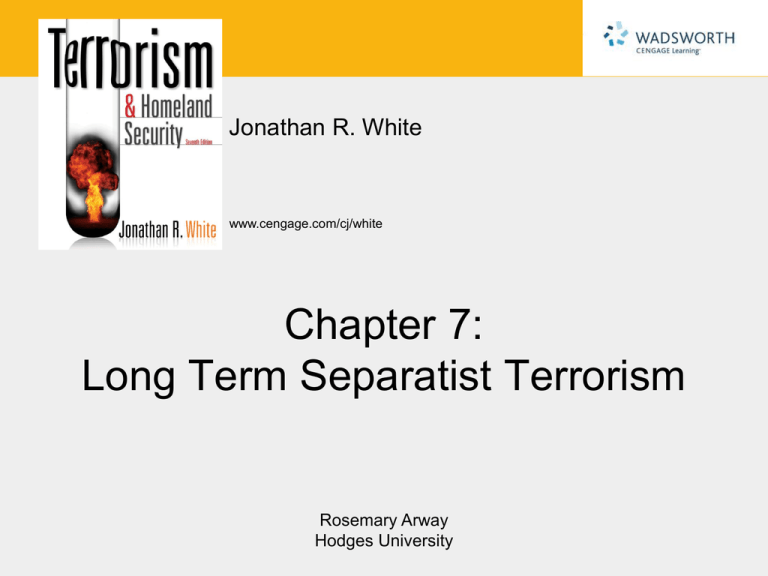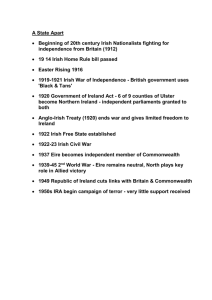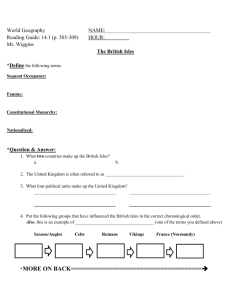Sociology in Our Times: The Essentials
advertisement

Jonathan R. White www.cengage.com/cj/white Chapter 7: Long Term Separatist Terrorism Rosemary Arway Hodges University The Irish Trouble: Vikings Irish culture originated with Celtic invasion 300 years before Christ. o Never united as a single entity under a Celtic ruler or political authority o Government was maintained through kinship and clans Viking raiders began attacking Ireland about 800 C.E. Brian Boru was declared High King of Ireland in 1014 and successfully revolted against the Vikings. The Irish Trouble: The Normans Normans were attracted to fortifications offered by Irish cities o As well as the agricultural wealth of the interior Normans were descendants of William the Conqueror. o Had ambitions for extending their domains o Staked territorial claims in Ireland o Found success due to new methods of warfare Normans ruled Ireland from 1171 till 1601. The Irish Trouble: The Normans Normans built castles to control Irish cities. o Irish peasants generally dominated rural areas. o The Irish maintained cultural and religious traditions. The Irish and English vied for dominance – Irish maintained tribal customs and clan structure ending in 1601. Irish nobles fled for mainland Europe. English and Scottish settlers laid claim to Ireland. Reformation and Ireland Protestant Reformation had tremendous impact on Ireland. King Henry VIII created independent Church of England in Ireland. o Irish Catholics revolted. o Trouble created by Reformation continues today. Elizabeth I o Plantation of Ulster o Ethnic division in Ireland fueled by religious differences and animosities. Reformation and Ireland Ireland in 1600s dominated by three major issues: o First, Plantation of Ulster displaced Irish peasants. ▪ Conquest not colonization o Second, English Civil War came to Ireland. ▪ Cromwell slaughtered thousands o Third, Ireland became base from which to revolt against William of Orange. ▪ Apprentice Boys Republican Revolutionaries Protestants and Catholics joined together for independence – they called themselves the Society of United Irishmen. o Theobald Wolfe Tone: ▪ ▪ ▪ ▪ ▪ Member of Church of Ireland Demanded freedom for Catholics Demanded the end of Penal laws Irish independence more important than religious differences Led French troops in a revolt Facing a French invasion from Ireland, United Kingdom of Great Britain was formed in 1801. Home Rule Act of Union – gave Ireland voice in the British Parliament Home Rule (Daniel O’Connel, Charles Parnell, John Redmont) – legislative drive for independence o Second parliament for Ireland free from direction British control o Ireland would remain part of United Kingdom o Citizens would swear allegiance to British monarchy o Exercise autonomy through their own prime minister and legislative body Home Rule: Unionists Protestants in the north were not in favor of Home Rule; they wanted to remain under British rule. o o o o Afraid of Catholics in the south Felt they would lose status Outnumbered Catholics Irish Protestant Unionists began to militarize their Orange organizations Early Irish Republican Army (IRA) Bell: Definitive treatise on origins and development of IRA. o Began with campaign of violence by Irish Republican Brotherhood (IRB) in late 1800s. o Bombings and assassinations from 18701916. o IRB activities frightened Irish citizens. o IRB leadership was dominated by men who believed each generation produced warriors who would fight for independence. o Provided basis for resurgence of Irish culture. The Easter Rising British promised home rule to Ireland at the end of WWI. Pearse and Connolly led a revolt in Dublin on Easter Day 1916. o They announced revolutionaries had formed an Irish Republic. Britain fought back militarily. IRB transformed into IRA. 1916 Easter Rising Political party of republicanism, Sinn Fein, had not gathered public support. o Irish popular opinion favored Home Rule o Uprising failed o British overreacted ▪ Death sentences ▪ Prison sentences o Execution of Pearse and Connelly garnered public sympathy The Black and Tan War Sinn Fein continued its activities in spite of the failure of the Easter Rising o Rejection of the home rule o Demand of a complete free state without British participation in Irish politic Michael Collins: o Revolution must be systematic, organized, and ruthless o Studied tactics of earlier anarchists and terrorists o Developed selective terrorism: After months of planning, recruiting and organizing Collins launched the IRA The Black and Tan War Collins continued campaign of terror against unionist and the RIC – Royal Irish Constabulary British response was hastily formed Military force called the Black and Tans (because of their mismatched uniforms) invited Ireland o Both sides employed tactics of murder and mayhem. o Conflict became known as The Black and Tan War. Separation and Independence Seeking to end violence in Ireland, politicians in Britain and Ireland formulated steps to grant Irish independence. Protestant unionists feared abandonment by British. 1921 treaty between Britain and Ireland (Micheal Collins): o Ireland would be granted independency. o Ulster would remain under British protection. o Southern Ireland became the Free State – the Republic of Ireland. Separation and Independence Civil war broke out o IRA fought Irish government forces claiming Irish independence extended to all Irish people ▪ Eamon De Valera ▪ Murder of Michael Collins o Rejected British control of the North o British tightened hold on North granting special powers to combat the IRA Ireland became a divided country. Trends in the IRA to 1985 1927 – De Valera become Prime Minister 1930s split in ranks of IRA o One group of the IRA believed in peaceful political expression of its ideals (James Connolly) o Second group of IRA (Provisional IRA) believed that purpose of the IRA was to fight ▪ IRA was active in England from 1939 to 1944 ▪ IRA launched ineffective terrorist campaign in Northern Ireland in 1956 ▪ Without the public support IRA called off its offensive in the North in 1962 Trends in the IRA to 1985 In 1969 Catholic civil rights campaign engulfed Northern Ireland o Demonstrations grew violent when Catholics demanded same rights as Protestants in 1969. Economic situations in Northern Ireland favored Protestant Unionists. o 1922 – 1966 civil rights of Catholics in Northern Ireland were reduced o Economic power of Unionists increased o Civil right workers and demonstrators become very active. ▪ In 1969 demonstration march from Londonderry to Belfast turned into fight with RUC (B-Specials) Trends in the IRA to 1985 British army had little to no appreciation of the historical circumstances behind the conflict: o Mistakenly allied itself with one of the extremist positions in the conflict o Republicans and Catholics became a subject of British Army oppression ▪ Feeling oppressed they found help in IRA Unionist organization created terrorists enclaves to terrorize Republicans o Unionist terror was based on retribution Negotiating an end to terrorism Anglo-Irish Peace Accord 1985 o Establishing a joint system of government for the troubled area In 1990 IRA announced ceasefire In 1998 Belfast Agreement (Good Friday Agreement) was signed: o Call for independent human rights investigations, compensation for the victims of violence, and decommissioning of parliamentary groups In 2005 IRA announced end of its campaign in 2005 In 2010 the British Government, after conducting investigation, publicly apologize to the demonstrators for the Army’s actions in 1972 on Bloody Sunday. The Basque Nation and Liberty (ETA) Basque region: located in Spain, extended over the Pyrenees to France After the War of Spanish Succession (1702-1714) the Basque region was granted semi-autonomy. Spanish power gradually enfolded the region in the 20th century, sharpening ethnic and ideological divisions. In the Spanish Civil War (1936-1939) Republicans fought Fascists. o o Gen. Franco (Fascist) campaigned against Basque national identity; he banned the Basque language and cultural expression. In 1950 Basques formed government in exile in Paris. The Basque Nation and Liberty (ETA) ETA – Euskadia ta Askatasuna o o o Waged a campaign of violence since 1959 and has killed more than 800 people. Was organized by Basque students who were dissatisfied with the accommodation of the Basque government in exile (in France). Claimed an historical, linguistic, literary, and cultural identity that distinguishes them from both Spain and France. ▪ ▪ ▪ Firstly, group did not advocate violence. Later ETA decided to take an armed revolution. ETA split in1974 to ETA and ETA-M (militant wing). After Gen. Franco death, the Spanish government restored the Basque language and gave control over education to local governments. ETA tactics and Spanish Death Squads 1970s o ETA began a Marighella- style campaign of assassination, robbery and banditry. 1980s o Most violent year, 92 people killed o The emergence of the Spanish Death Squads ▪ Marital law failed, and Death Squads become to torture and murder suspected terrorists and supporters. ▪ Individual Death Squads evolved into GAL – AntiTerrorist Liberation Group. ETA tactics and Spanish Death Squads ▪ 1990s ▪ ETA conducted sporadic bombings ▪ In 1998 ETA agreed to a ceasefire ▪ In 1999 ETA came back to fighting ▪ In 2001 ETA murdered thirty foreign tourists, attacking Spain’s major industry. ▪ In 2006 ETA signed another ceasefire. ▪ In 2007 bombings reoccurred. ▪ In 2010 ETA signed another ceasefire. The Liberation Tigers of Tamil Emil (LTTE) Tamils are an ethnic minority in southern India and Sri Lanka. LTTE was found in 1976 by Velupillai Pirapharan. LTTE population were bolstered by religious and ethnic identity. LTTE used terrorism as a prelude to guerilla warfare and to support uniformed guerillas in field. In 2009, Sri Lankan government declared victory over LTTE. The Liberation Tigers of Tamil Emil (LTTE) History of LTTE struggle: o After II World War Tamils were represented in Sri Lanka government. o In 1955 Sinhalese majority forced the government to adopt a Singhalese only policy. o The Ceylon (Sri Lanka) government (Sinhalese majority) began to target minority Tamils in the 70s and 80s. o Following Sinhalese rioting in 1983, the LTTE mounted three on-again, off-again terrorist campaigns. The Liberation Tigers of Tamil Emil (LTTE) TACTICS: o Standard guerilla tactics from 1988 to 1992 o Bank robberies, bombings and murder o In 1987 LTTE pioneered the use of suicide bombings o In 1990 LTTE organized Naval force ▪ threatening shipping operations with suicide boats and other seaborne operations o In 1994 and 1995 LTTE organized itself as a uniformed military force The Liberation Tigers of Tamil Emil (LTTE) In 1995 Sri Lanka government signed a peace agreement with LTTE. o The peace accord broke down and Sri Lanka forces launched an all out attack on Tamil strongholds. LTTE returned to the campaign. In 2002 ceasefire was renewed. In 2005 a LTTE sniper shot dead the Sri Lankan Foreign Minister. The Liberation Tigers of Tamil Emil (LTTE) Fighting resumed in 2006. In 2008 Sri Lankan Security Forces began a major military offense: o ‘no-fire’ zones were created o Forces moved to Tamil areas o Tamil population was given an option: ▪ Stay and fight ▪ Move to no-fire zones ▪ Sri Lanka won, but the International Crisis Groups notes that there is still a danger that ethnic violence will restore in the future. Critical Engagement: Separatist Negotiations Neuman: o Nationalistic separatists present a unique opportunity for negotiated settlements because they have recognizable goals. o The first step in negotiation is recognition of group attitude toward the use of violence: ▪ Questioning the utility of violence gives chances in negotiation. o Secondly, group’s ability to control its own members must be recognized: ▪ Lack of structure and effective command would not help negotiation. Critical Engagement: Separatist Negotiations Neuman’s pragmatic guidelines for negotiation: o If government appears to eager to negotiate, it may backfire. o Agreement on a ceasefire must precede negotiations. o Negotiations must address both the political settlement and the welfare of the terrorists. o Negotiations must be broadly based. o Terrorist must agree to become a part of the democratic process and renounce violence.








